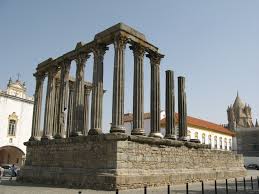The Roman Temples and the history of Roman Architecture were divided into two distinct eras. The first era was the Roman Republic where the origins of Roman architecture can be traced to the Etruscans, who migrated from Asia Minor to Italy in the 12th Century BC.
Ancient Roman Temples
The ancient Etruscans mirrored the Greek and the Phoenician traditions building large temples to honor their Gods. The second era started in 27BC and is classed as the period of the Roman Empire.

The Romans built temples to worship their Gods and Goddesses. Roman temples featured some, or all, of the following:
1.Roman Temples had a gabled roof
2.A deep porch with free-standing columns
3.A frontal staircase giving access to a high platform
4.Outside the Roman Temples, traders sold small birds and animals which were offered to the Gods as sacrifices
5.The Roman temples were located in important positions such as at one side of the forum or along a major road
6.The distance between Temple columns was proportional to the diameter of the column
7.Engravings of Roman Temples were featured on Roman coins
Roman Temples Architecture
In Ancient Rome a fundamental basis of the religion was the belief that if the Gods and Goddesses were happy then they would receive good fortune. It was, therefore, important to worship the Roman deities on both a daily basis and by special pilgrimages. Sacrificial offerings were made to the gods. The types of sacrifices were very specific.

The sex of the animal had to correspond to the sex of the god or goddess to whom it was offered. White animals were sacrificed to the gods of the upper world whereas black animals to the underworld. Outside the temples, various traders sold small birds and animals for the Romans to offer Roman Temples were dedicated to specific Roman Gods and Goddesses.
New materials were used in the construction of Temples such as concrete with brick and stone facing and marble veneers. Walls of Roman Temples were painted in fresco – the frieze often depicted Roman life. Sculptures of Roman Gods and Goddesses were used as decoration in the form of free-standing statues.
Roman Temples Facts
Many Roman Temples were commissioned by Roman Generals to thank the Gods for the generals’ victories. In Ancient Rome a fundamental basis of the religion was the belief that if the Gods were happy then they would receive good fortune. It was, therefore, important to worship the Roman Gods on a daily basis. Temples were large, ornate and numerous.

In 312AD the emperor Constantine the Great believed he had received a sign from the God of the Christians in a dream on the night before an important battle. The battle and Emperor Constantine showed his gratitude by converting to Christianity. The whole of the Roman empire followed the lead of their emperor and the great Temples began their decline.



